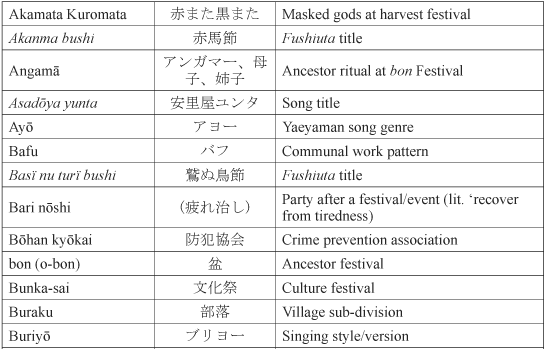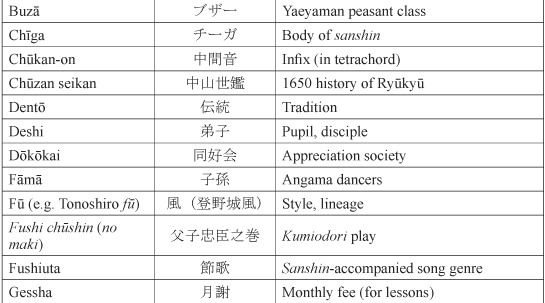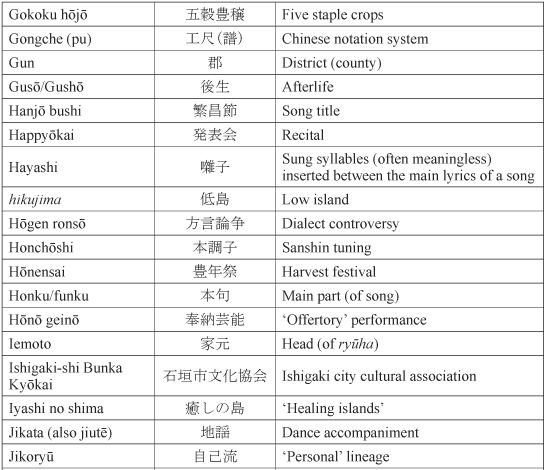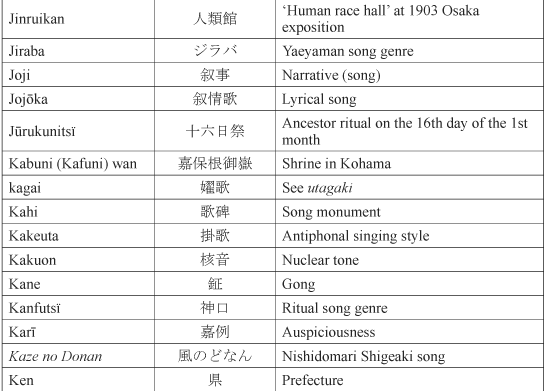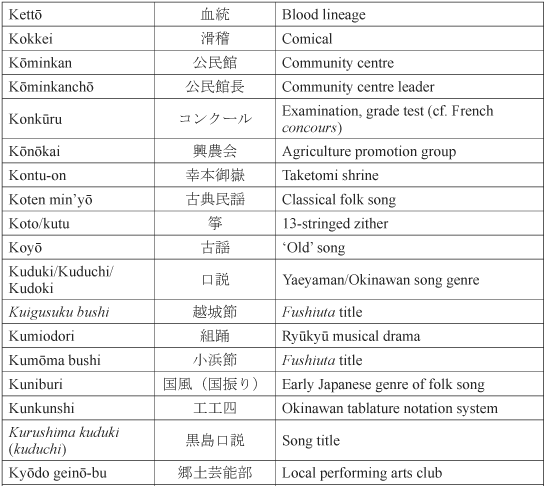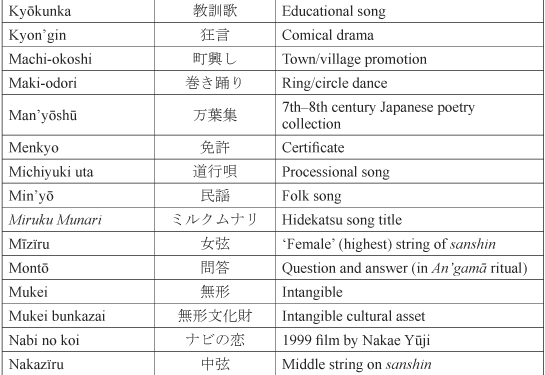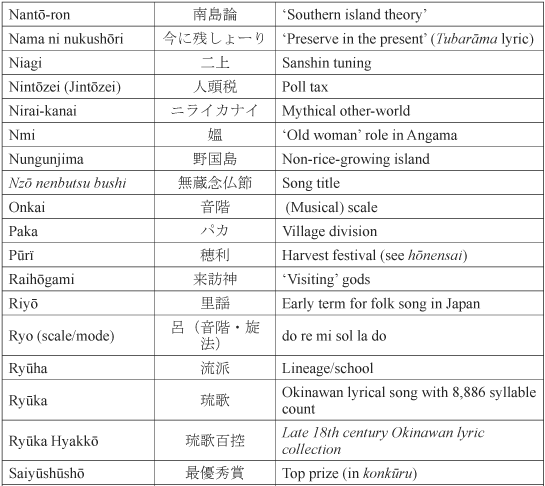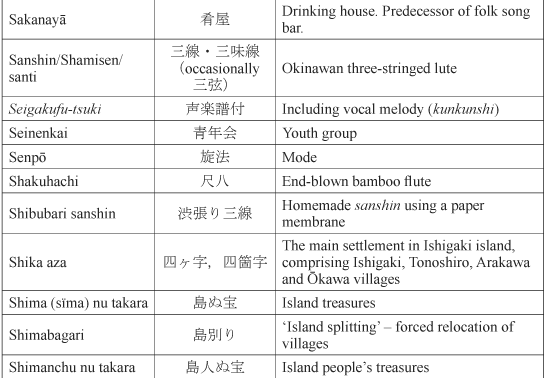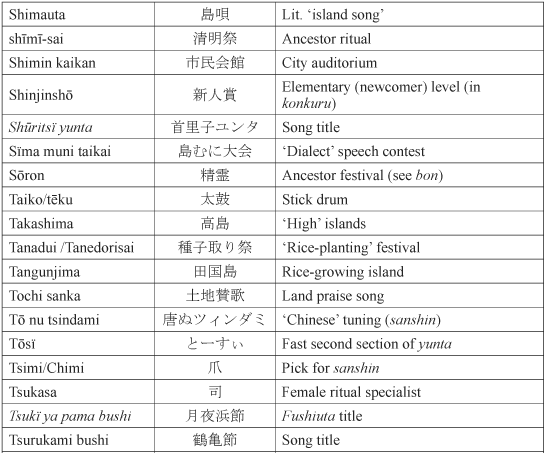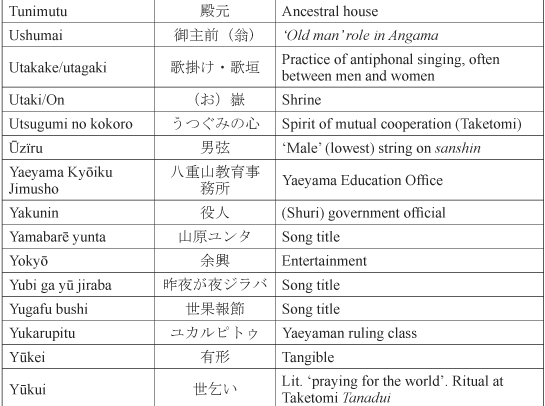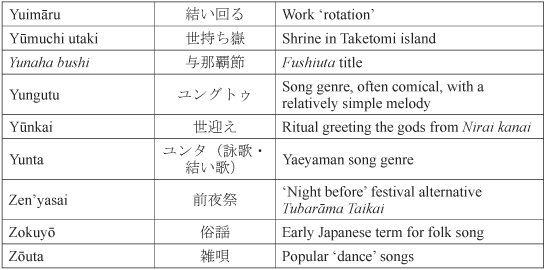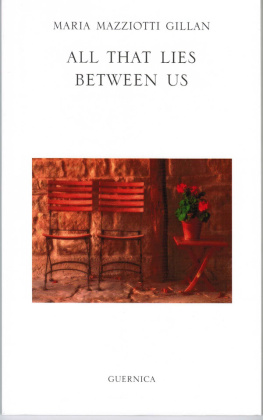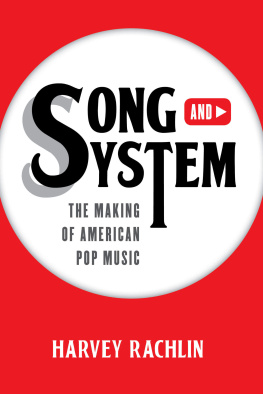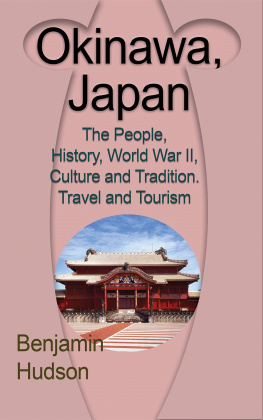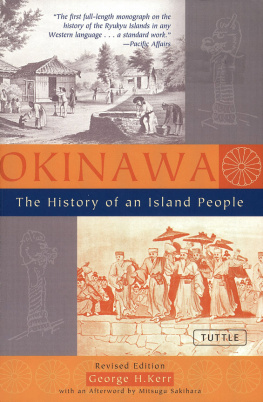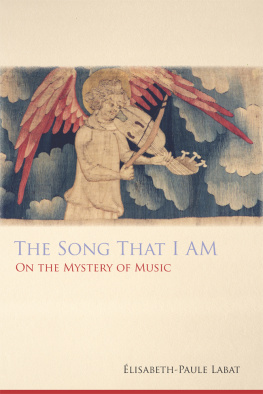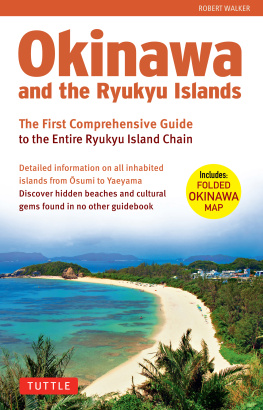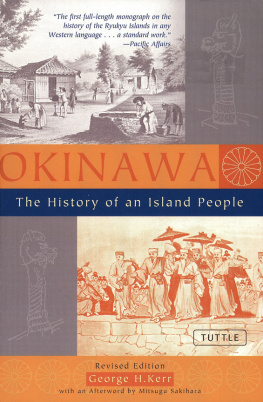Acknowledgements
This book is the result of more than 10 years research into Yaeyaman and Okinawan music. During that time I have been incredibly fortunate to receive academic, financial and moral support from a large number of organizations and individuals. It would be impossible to list all of them here, and I apologise for any that have been inadvertently omitted.
The research on which this thesis is based was made possible through generous financial assistance from several bodies. The initial period of fieldwork between 2001 and 2002 was carried out as part of a PhD project funded by the British AHRB (AHRC). A further grant for a short research trip in Osaka in spring 2004 was provided by Osaka City University. Between 2005 and 2007 I was able to continue my research into Yaeyaman music as part of a post-doctoral research project at Okinawa Prefectural University of Arts under the sponsorship of the Japanese Society for the Promotion of Science. Since 2007 I have also made several short trips to Okinawa with financial assistance from International Christian University in Tokyo.
Throughout this project, I have been fortunate to receive advice and guidance from many prominent ethnomusicologists and researchers. Thanks must go first of all to David Hughes, my PhD supervisor at the School of Oriental and African Studies, without whom my career in ethnomusicology would not have begun, and who has provided consistent support since I began a masters degree in ethnomusicology in 1998. During my time at SOAS I received advice and assistance from several faculty members of the music department and fellow students. Particular thanks to Keith Howard, Steven Jones, Owen Wright, Rachel Harris, and Richard Widdess. Also in London, I have benefitted greatly from many conversations with the musician and Okinawa specialist Robin Thompson.
At Okinawan Prefectural University of Arts in Naha I am particularly indebted to Kaneshiro Atsumi for acting as my academic advisor both during my initial fieldwork research and again during a postdoctoral research project. Also at the Prefectural University of Arts, Kumada Susumu and Hateruma Eikichi have also been consistently positive towards my research, and tolerant of my frequent misunderstandings of issues surrounding Okinawan music. Shinj Wataru and Takahashi Miki, both graduates of the university, have also provided numerous comments and introductions that have helped my studies progress. Also in the Okinawa mainland, the researchers Higa Etsuko and shiro Manabu have also been helpful in providing contacts and information over the years.
In Tokyo, Sakai Masako has been continually supportive of my research and has generously shared many of her research results and recordings with me. James Roberson of Tokyo Jogakkan College, in addition to providing insightful comments as examiner for my original PhD thesis, has on several occasions enhanced my understanding of Okinawan pop music through informal conversations. At International Christian University in Tokyo, I have been fortunate to work since 2007 with a multi-disciplinary faculty who have broadened my scholarly horizons immensely. Particular thanks to Itoh Tatsuhiko in the music department for academic and moral support.
In the Yaeyaman musical community, I have been overwhelmed by the extent that people went out of their way to help me. Special thanks must go to Tominaga Hide, Yamazato Setsuko, and all the members of the Tonoshiro Kay no Kai, who welcomed me into their midst, and the regular practice sessions on Tuesday evenings, as well as excursions to play ground golf, were among the highlights of my time in Yaeyama. Yamazato Setsuko also provided me with introductions to a number of performers and koy groups in Yaeyama, and was an endless source of knowledge on many aspects of Yaeyaman culture. Special thanks also to my fushiuta teacher soko Chy who has been both a fount of knowledge on many aspects of Yaeyaman music, and a patient teacher to an erratic student. The veteran singer Yamazato Ykichi took me under his wing from the very first days in Okinawa, and provided information about aspects of Yaeyaman music in the Okinawan mainland, as well as teaching me much about aspects of performance. I have also spent many happy evenings over the years in Asadoya, the folk song club owned by the performer Asato Isamu, who also took me on regular fishing expeditions around Yaeyama. In the Okinawan mainland, take Zenz taught me much about fushiuta performance between 2005 and 2007. Tyama Zend also provided me with important insights on fushiuta performance and history on a number of occasions.
I have had extensive connections with Taketomi islanders, both those living in Ishigaki and in Taketomi itself. yama Takeshi provided me with a number of introductions as well as much constructive advice, as well as organizing a leaving party at the end of my fieldwork that I will never forget. Ishigaki Hisao, president of the Yaeyama Bunka Kykai allowed me access to the practices of the Hazama Gein Hozonkai in his home during the weeks before the Taketomi Tanedori-sai, as well as providing me with information about other Taketomi groups. The Yaeyaman scholars Ishigaki Shigeru and Ishigaki Hirotaka of the Yaeyama Bunka Kenkykai offered extensive information on many aspects of Yaeyaman song, particularly help with the many problems I faced understanding local dialects. The local writer and scholar Morita Sonei gave me extensive advice on Yaeyaman lyrics, as well as providing information about the workings of the Tubarma Taikai, and the Yaeyama Mainichi Shinbun-sponsored sanshin grade tests. ta Shizuo guided me on several occasions to ritual events around Ishigaki island, including a memorable music session in front of his family grave.
Finally, studying Yaeyaman music has constantly reminded me of the importance of family. Love and thanks to family members in my three shima of England, Yonaguni and Tokyo, without whom I would not have got this far.
Shikai tu nfaiy.
Appendix 1: Glossary of Japanese, Yaeyaman and Okinawan Terms
